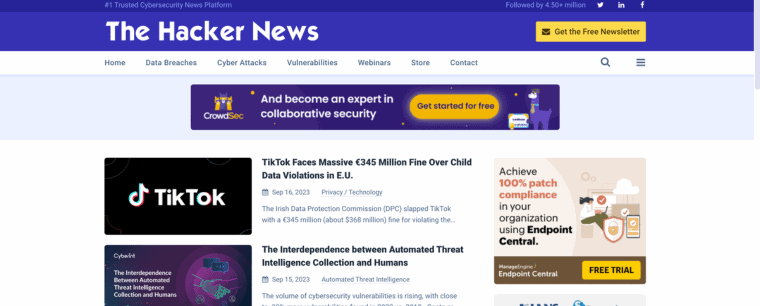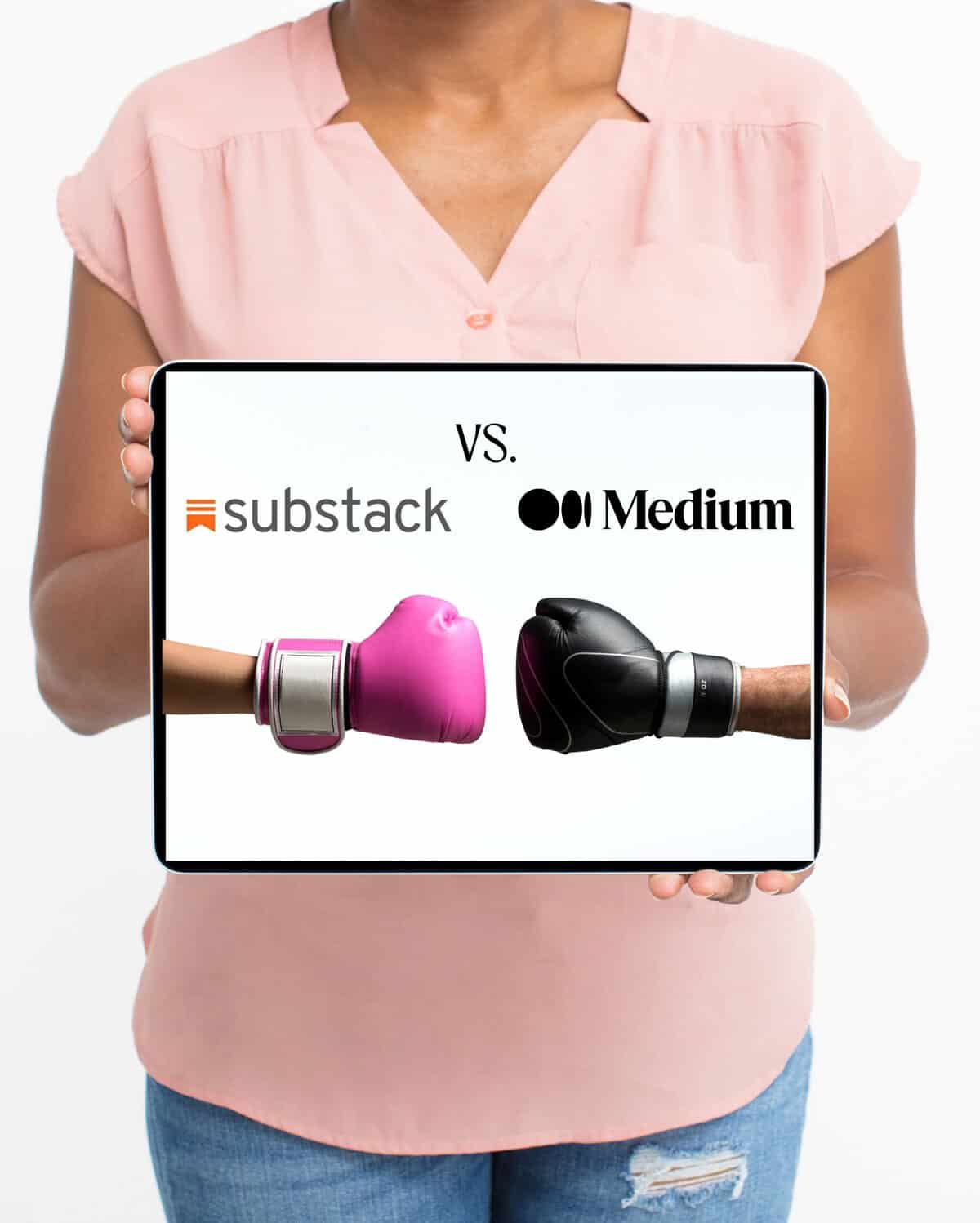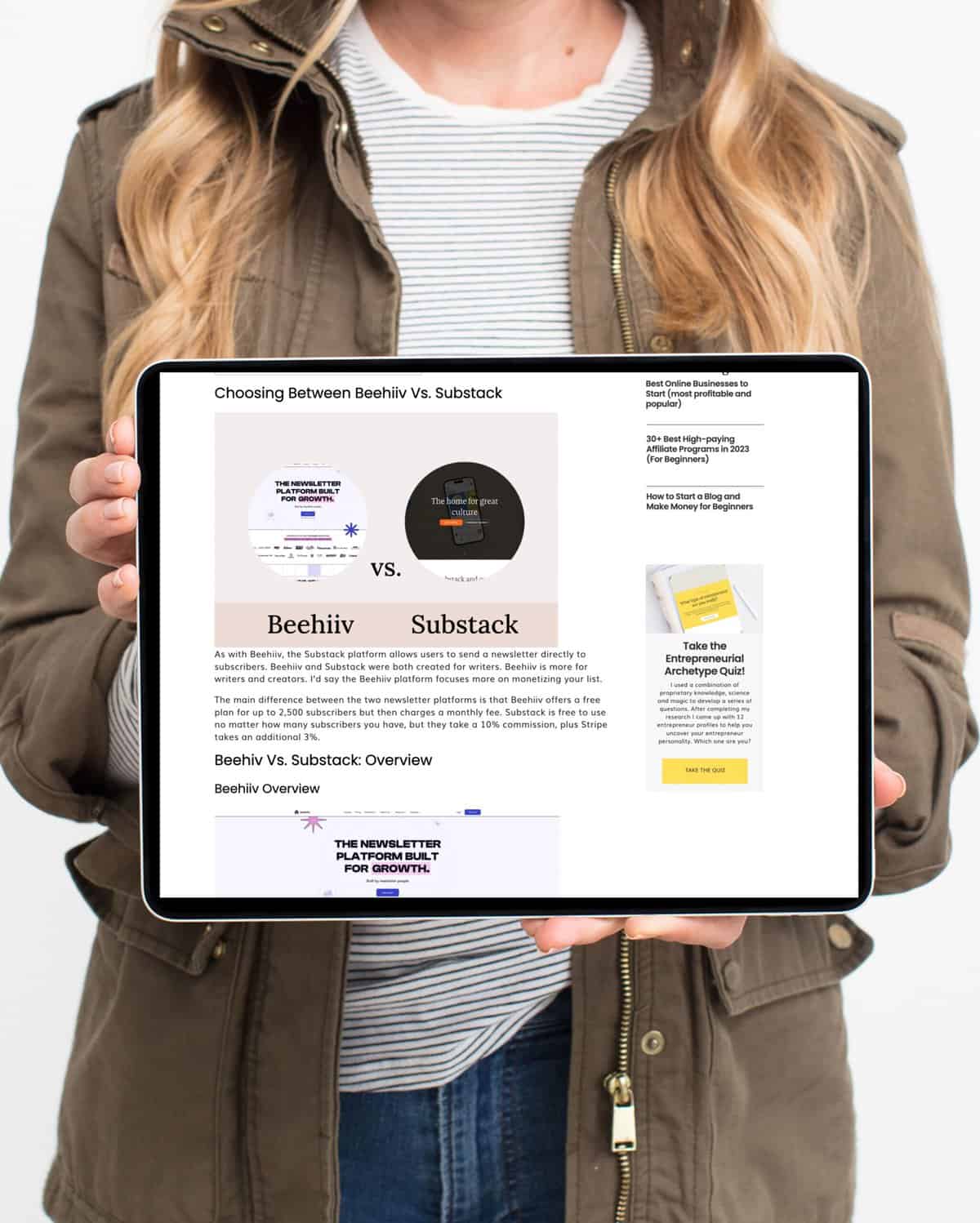This page may contain affiliate links. Please read my disclosure for more information.
Tech blogs are becoming more popular every day, and they will continue to grow. If you’re into the tech industry, read other tech blogs, and have wondered how to start a tech blog, you’ll find the answers in this article. I’ll give you a detailed, easy-to-follow, step-by-step guide on how to start your own tech blog.
I’ll also interview Kristoffer Thun, an IT Consultant turned Tech Blogger. His journey from being an IT consultant to harnessing his passion and experiences into a tech blog offers valuable insights for all aspiring tech bloggers (and dad bloggers).
How to start a tech blog in 6 easy steps:

1. Understand Your Purpose and Target Audience
There are many reasons to start a tech blog, such as a creative outlet, a passion for tech, or making money online.
Creative Outlet
A tech blog can be a creative outlet that allows you to express your unique perspective on technology, innovations, and the latest trends. It lets you share your opinions, tech product reviews, and experiences. Whether writing about the newest mobile phone tech products or diving into software applications, a tech blog lets you channel your thoughts and creativity in a structured manner.
Passion for Tech
Many tech enthusiasts have a genuine love for all things technology. A tech blog becomes a dedicated space for you to indulge in this passion. It offers a chance to stay updated with the tech industry, learn about the best tech startups, interact with other tech lovers, and even provide tech support or tutorials to those in need. It’s not just about discussing the latest tech news but also about being part of a community that understands and shares the same excitement for tech.
Making Money Online
A successful tech blog can be a lucrative online business. With a dedicated and large audience, you can explore many monetization strategies. There are a ton of tech blog advertising networks, affiliate marketing programs, sponsored posts, and even opportunities to sell tech merchandise that can generate income. As your technology blog gains traction, brands may also approach you for partnerships or to review tech products.
2. Choose Your Tech Niche

Before starting a tech blog, you must choose and commit to a blogging niche. It will help provide your tech blog with clarity and direction and attract readers. It allows you to channel your energies so your content is well-researched and engaging and caters to a specific target audience. Search engines favor niche-focused tech blogs, enhancing your search engine ranking and visibility.
Whether you’re an avid follower of AI artificial Intelligence or wish to create content to help others understand tech products, there’s a space for every tech blogger. All you need is passion, consistency, and a clear vision.
Tech Blogging Niche Ideas

Once you choose your tech niche, you can choose a name for your blog business. Here’s a list of tech blogging niches that aspiring tech bloggers can consider:
- Mobile Technology – Covering smartphone reviews, comparisons, operating systems, and app recommendations.
- Software Reviews and Tutorials – Evaluating different software applications, providing tutorials, and offering troubleshooting guides.
- Hardware Reviews – Delving into PCs, laptops, graphic cards, processors, monitors, and more.
- Gaming – Reviews of the latest games, gaming consoles, gaming PC builds, game development, and esports coverage.
- Wearable Tech – Focusing on smartwatches, fitness bands, augmented reality glasses, and other wearables.
- Internet of Things (IoT) – Discussing smart home devices, IoT trends, security concerns, and innovations.
- Cloud Computing and Big Data – Exploring the latest in cloud technologies, platforms, big data tools, and trends.
- Cybersecurity – Covering the latest security threats, protection tools, cybersecurity news, and tips to stay safe online.
- Artificial Intelligence and Machine Learning – Discussing the advancements, applications, ethics, and future of AI and ML.
- Virtual Reality (VR) and Augmented Reality (AR) – Reviewing the latest gear, software, and applications in the immersive tech space.
- Blockchain and Cryptocurrencies – Covering the latest cryptocurrency news, blockchain technology insights, and market trends.
- Tech Industry News – Focusing on the latest happenings, mergers, acquisitions, and major events in the tech industry.
- Digital Marketing and SEO – Offering insights into online marketing tools, strategies, SEO tips, and updates.
- Web Development and Design – Tutorials, reviews, and insights into web design, CMS platforms, and programming.
- E-commerce and Fintech – Discussing online business trends, payment gateways, and innovations in the financial technology sector.
- Drones and Robotics – Exploring advancements, reviews, and uses of drones and robotics in various industries.
- Tech for Kids – Focusing on educational tech tools, apps, and gadgets specifically designed for children.
- Health Tech – Discuss innovations in health tech, including telemedicine, wearable health devices, and digital health strategies.
- Green Tech and Sustainability – Covering technologies that support environmentally friendly practices and sustainable solutions.
- Tech Startups – Showcasing emerging tech companies, their innovations, challenges, and success stories.
- Tech News Blog – If you’ve got your finger on the pulse of the tech industry, you could cover the latest happenings, breakthroughs, company mergers, and tech industry trends.
- Tech Tutorials – Many tech enthusiasts and users often seek guidance. Creating how-to guides, video tutorials, or explainers on software, hardware, or coding can set you apart. If you’re adept at breaking down complex tech topics into digestible content, this niche is golden.
3. Set Up Your Tech Blog

You have many options to choose from when starting your blog. There are free blogging platforms and paid ones. Free blogging platforms like Wix, Weebly, and Squarespace may be free initially but may come with drawbacks and limit your growth in the future.
Choose your website and blogging platforms
If you’re a beginner or a seasoned blogger, you’ll need to choose platforms for your website, blogging, and web hosting. You can start with a free blogging platform. I recommend Showit for your website and WordPress.org for your blogging platform. I use both and love them. Here’s why:
Website Platform: Showit
- Its drag-and-drop interface makes it extremely user-friendly. You don’t need to be a tech whiz to create a stunning website.
- Showit offers design freedom, allowing you to translate your vision into reality without the constraints typical of other platforms.
- A significant advantage of using Showit is that web hosting is already included. You don’t need to find and set up a separate web host.
- They offer free blog themes for your website, or you can purchase custom blog themes on Tonic.
Blogging Platform: WordPress.org
When it comes to most blogging platforms and your content management system, WordPress.org is the only way to go.
- It seamlessly integrates with Showit and gives you a robust blogging platform that’s visually appealing.
- WordPress.org offers extensive plugins, ensuring you can easily add any functionality to your blog.
- With the right plugins and tools, optimizing your tech blog for search engines becomes much easier.
4. Create High-Quality Content

A big part of learning how to start a successful tech blog, is creating content. Valuable content for a tech blog goes beyond just writing. It’s a blend of in-depth research, genuine interest, and the ability to communicate complex concepts in understandable terms. Here’s a guide on how you can create content that stands out:
Importance of Writing Skills
Your writing skills lay the foundation of trust with your readers. Well-researched, error-free, and articulate content positions you as an authority in a specific niche. Use Grammarly to ensure your articles are polished and professional.
High-quality content not only informs the reader but keeps them engaged. Your writing should resonate with tech enthusiasts and casual readers, making them want to come back for more.
Create Content for Tech Enthusiasts
The tech industry evolves rapidly. Stay updated with the latest trends, breakthroughs, and products so your content is always relevant. Utilize platforms like message boards, tech forums, or even the comments section of your blog post to understand what topics or concepts your readers are curious about.
How to Review Tech Products
It’s helpful to have firsthand experience with a product before reviewing it. This lends authenticity to your tech reviews and makes them trustworthy. Every product has its strengths and weaknesses. Highlight them honestly, ensuring your readers get a well-rounded view. If possible, compare the product with others in the market. This provides context and helps readers make informed decisions.
Explain Tech Concepts in Simple Terms
Analogies can be a powerful tool to explain complex tech concepts. For instance, comparing a computer’s RAM to a human’s short-term memory can make the concept more relatable. Infographics, diagrams, and flowcharts can break complex ideas into digestible, easy-to-understand chunks.
Incorporate Tech Tutorials and Tech Talk
When creating tutorials, break down the process step by step. Ensure each step is clear and accompanied by relevant images or screenshots. Engage with other tech bloggers or industry experts and host tech talk sessions or interviews on your blog. This provides different perspectives and adds value to your content. You can also share tidbits on how to start a tech blog with your target audience.
Set up a Content Calendar
When it comes to writing content, just get started. The more you write, the better your content will become. Your first blog post might not be your best, and that’s okay. A successful blog post or article is a living, breathing document that can be constantly improved and updated.
Consistency is key in blogging. Plan out topics in advance and set a schedule. This helps you stay organized and ensures regular content for your readers. Use a spreadsheet to organize your posts and focus on keywords with low competition.
Your first post could be an in-depth how-to guide, a top 10 best-of post, or a tech review. Use Ahref’s for keyword research and SurferSEO to help with the correct article keywords for SEO.
5. Monetize Your Tech Blog

There are many ways to make income with your tech blog. Here are some of the best methods to monetize your technology blog:
Affiliate marketing
This involves promoting products or services from other companies in your blog posts and earning a commission on each sale you generate. There are many different affiliate programs available, so you can find ones relevant to your particular niche and blog readers. Research the best affiliate marketing program for your specific niche.
Sponsored content
This involves writing articles or reviews for products or services in exchange for payment. It’s essential to be transparent with your readers about sponsored content and to only promote products or services that you genuinely believe in.
Advertising
This involves placing ads on your technology blog from Ad Blog Networks and companies willing to pay to reach your audience. You can use ad networks like Google AdSense to make it easy to get started with display advertising.
Premium content
This involves offering exclusive content to your readers for a fee. This could include e-books, online courses, or webinars.
Consulting services
If you have expertise in a particular area of tech, in addition to understanding how to start a tech blog, you can offer consulting services to businesses and individuals. This can be a great way to monetize your own tech blog niche, and share your knowledge with others.
E-commerce
You can also sell your own products or services on your blog by starting an online store. This could include physical products, digital products, MMR Products, or even services like coaching or consulting.
Events
If you have a large audience, you can host events such as meetups, conferences, or workshops. This can be a great way to monetize your technology blog and build relationships with your readers.
Online Courses
As you establish authority and trust with your target audience, offering a course on a specialized tech topic can provide value to your readers and generate revenue for you. Whether it’s a course on Web Design, UX design or even how to start a tech blog, the possibilities are endless. By using your blog as a platform, you can promote and sell courses tailored to the needs and interests of your target audience, ensuring both educational value for them and a steady income stream for you.
Mastermind
Another innovative way to monetize your tech blog is by starting a mastermind group. A mastermind is a peer-to-peer mentoring concept where members support and advise one another. For tech enthusiasts, this provides a platform to deep dive into specific tech topics, share experiences, or even troubleshoot common challenges. By offering exclusive access to a mastermind group through a subscription or one-time fee, you generate revenue and foster a tight-knit community around your technology blog. This enhances user engagement and positions you as a thought leader in your tech niche.
6. Boost Your Tech Blog’s Visibility

Driving traffic to your tech blog helps your content and tech blog be seen and shared. Here’s how you can amplify your technology blog’s visibility using various tools and strategies:
Keyword Optimization
The first step in boosting visibility is understanding what potential readers and search engines are looking for. Tools like Ahref’s can guide your content strategy and help you find a few keywords, ensuring you’re covering topics that other tech enthusiasts are actively seeking.
SEO Best Practices
Use high-quality backlinks, optimize meta descriptions, and ensure your tech blog is mobile-responsive. These elements play a crucial role in improving your search engine ranking.
Social Media Accounts
Sharing your tech news, tech reviews, and tech tutorials on your own social networks like Twitter, Facebook, and YouTube can significantly boost traffic. Sites like Pinterest can also be valuable, especially for tech infographics or visuals.
Build Relationships
Networking with other bloggers can open doors to collaborations, whether it’s co-writing a blog article or hosting joint webinars.
Guest Posting
Writing a guest post on other reputable tech blogs has many benefits. It can introduce your content to a wider audience and drive traffic back to your site. Similarly, featuring guest posts from other tech bloggers and experts on your own tech blog can bring their audience to you.
Tech Forums
Actively participating on sites like Reddit or niche-specific tech blogs and forums are goldmines for targeted traffic. By actively participating, creating content, answering questions, and sharing your expertise, you can direct potential readers to your blog.
Best Tech Blogs
Some of the best tech blogs focus on a specific tech blog niche.
Mashable

Mashable is a popular tech blog that covers a wide range of topics, from news and trends to reviews and analysis. It is known for its engaging and informative content, as well as its strong social media presence.
TechCrunch

TechCrunch is a blog that covers startup news, tech industry trends, and venture capital.
MIT Technology Review

MIT Technology Review is a blog that covers scientific breakthroughs, technological innovations, and the impact of technology on society.
Lifehacker

Lifehacker is a blog that offers tips and tricks on how to use technology to improve your life.
Hacker News

Hacker News is a social news aggregator that focuses on technology and programming.
Interview with a Tech Blogger

In this interview, you’ll meet tech blogger Kristoffer Thun and get to see just how he, as an entrepreneur, balances being an IT Consultant, Tech Blogger, and father of two.
1. Introduce yourself – tell us about your business and customers.
As a tech lover and experienced IT consultant, I balance my passion for the latest technology with the joys of being a father and a passion for outdoor adventure. You can find me in the kitchen when I’m not troubleshooting technical issues or spending time with my two kids. Through my tech blog business, I channel my vast technical and business insights and strive to enlighten and inspire others with my accumulated knowledge.
2. What inspired you to start your own business?
A burning passion and an insatiable desire for freedom are at the heart of my entrepreneurial journey. It’s exciting to chase limitless opportunities while moving at my own pace, all with the flexibility to shape my destiny. It’s inspiring not to know what’s around the corner but to constantly be curious, explore, and learn.
3. What are the most important lessons you’ve learned as an entrepreneur?
Believing in myself and persevering has always been a challenge but something I have learned to improve.
4. What resources, such as books, courses, or mentors, have been helpful in your personal and professional development?
- Slight Edge by Jeff Olson
- Tuesdays with Morrie by Mitch Albom
- Atomic Habit by James Clear
- The Millionaire Fastlane by MJ DeMarco
5. What platform, software or tools do you use to run your business? (Shopify, ConvertKit etc.)
- Wpx Hosting,
- WordPress,
- Midjourney,
- Canva,
- Ahref,
- Grammarly,
- Surfer SEO.
6. How do you maintain a work-life balance as an entrepreneur?
I know firsthand how challenging it can be to juggle a full-time job and caring for two toddlers. I find time at night when I can focus. However, I am constantly working to improve my work-life balance.
7. What advice would you give aspiring entrepreneurs who are just starting their journey?
Stick to one thing, and stay focused. Find your why; it will be the fuel that gets you through tough times.
Where can people find you?
Website: kristofferathun.com
LinkedIn: https://www.linkedin.com/in/kristoffer-thun/
Facebook: https://www.facebook.com/kristofferthun1
Wrapping Up
Learning how to start a tech blog requires passion and commitment. As we’ve discussed, success hinges on defining your tech niche, producing high-quality content, focusing on low-competition keywords, optimizing for visibility, and generating income from your tech blog by using different ways to monetize your tech blog. You can continuously maintain and improve your blog by using Google Analytics.
FAQ: How to Start a Tech Blog

Q1: Why should I start a tech blog?
A: Starting a tech blog can be a way to express your passion for technology, share your unique perspective, connect with a like-minded community, and earn an income.
Q2: What niche should I choose for my tech blog?
A: Choosing tech niches helps target a specific audience. Whether you’re passionate about AI, mobile technology, gaming, cybersecurity, or any other tech field, there’s a niche for everyone.
Q3: Which platforms are recommended for a tech blog?
A: For website design, Showit is user-friendly and offers excellent design flexibility. For blogging, WordPress.org is robust, versatile, and integrates seamlessly with various platforms. Showit customer service will help you set up your WordPress blog with your Showit website.
Q4: How do I create high-quality content?
A: Prioritize well-researched, error-free, and articulate writing. Use tools like Grammarly, stay updated with tech trends, and strive to explain complex topics in simple terms.
Q5: What are some effective ways to monetize my tech blog?
A: Options include affiliate marketing, sponsored content, display advertising, selling premium content or e-courses, consulting services, and hosting paid events or mastermind sessions.
Q6: How can I increase my tech blog’s visibility?
A: Implement SEO best practices, regularly share content on social media, engage in tech forums, network with other bloggers, and consider guest posting.
Q7: Do I need to be a tech expert to start a tech blog?
A: While expertise can be beneficial, passion and commitment are crucial. As you dive deeper into tech blogging, your knowledge and expertise will naturally grow.
Q8: How frequently should I post on my tech blog?
A: Consistency is key. Whether you post daily, weekly, or bi-weekly, choose a schedule that you can maintain, and that keeps your readers engaged.
Q9: Are there any tools to help with keyword research and SEO?
A: Yes, tools like Ahref’s and SurferSEO can guide your content strategy, ensuring it aligns with what people interested in tech are actively searching for.
Q10: How do I handle sponsored content ethically?
A: Always be transparent with your readers about sponsored content and only promote products or services you genuinely believe in or use.
If you resonate with the inspiring stories you’ve read here and have your own incredible journey as a self-made entrepreneur (or know someone). You could be featured in our next article and make an impact on aspiring entrepreneurs.
Your story could be the catalyst someone needs to embark on their own remarkable journey of success.
Want to be interviewed and featured? Complete this form to request an interview.







+ show Comments
- Hide Comments
add a comment